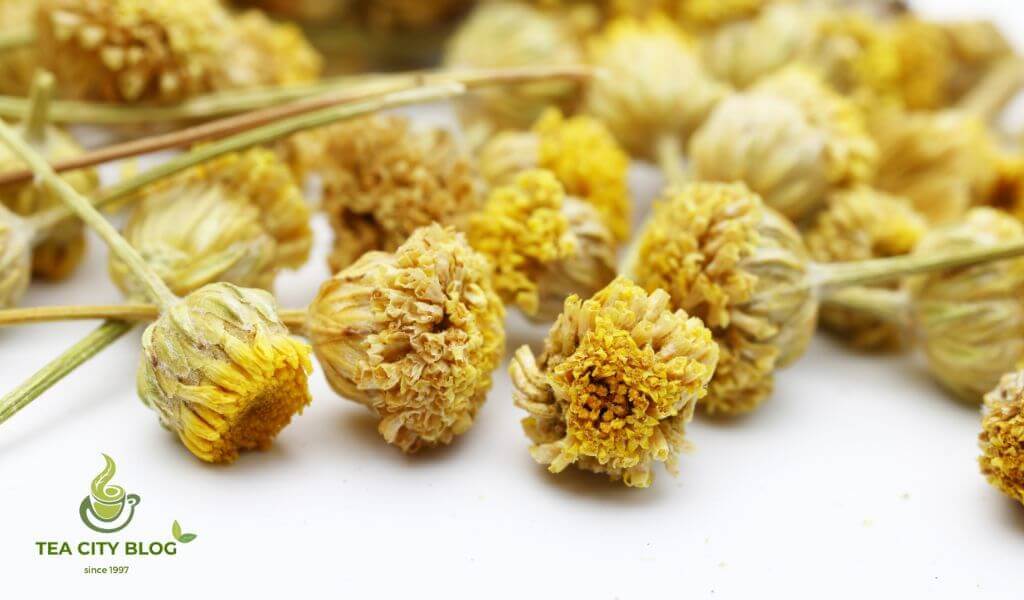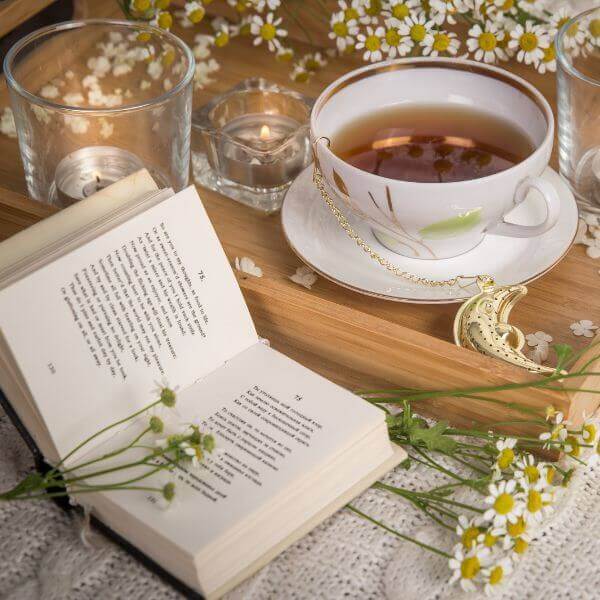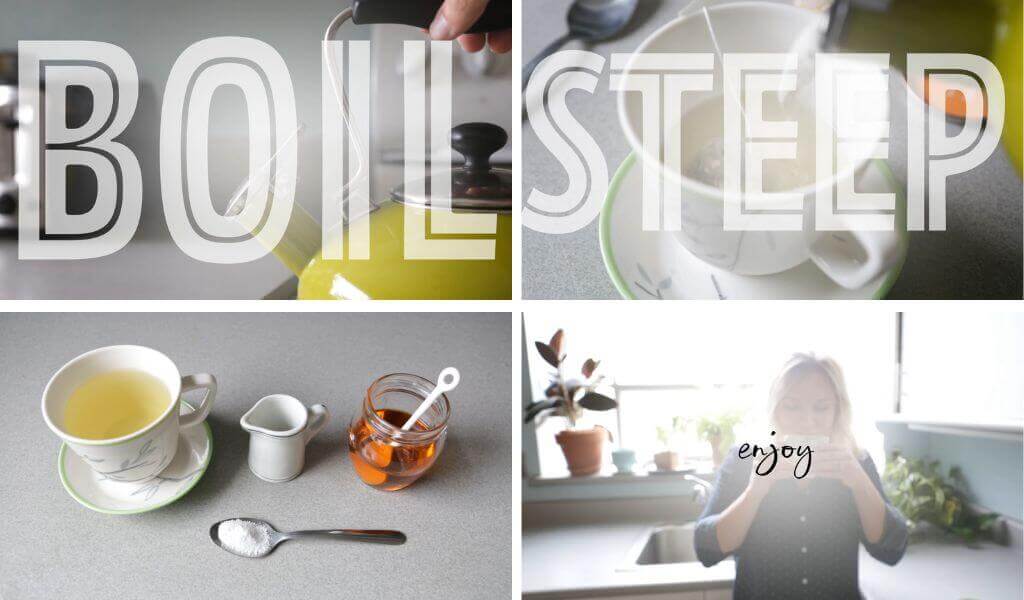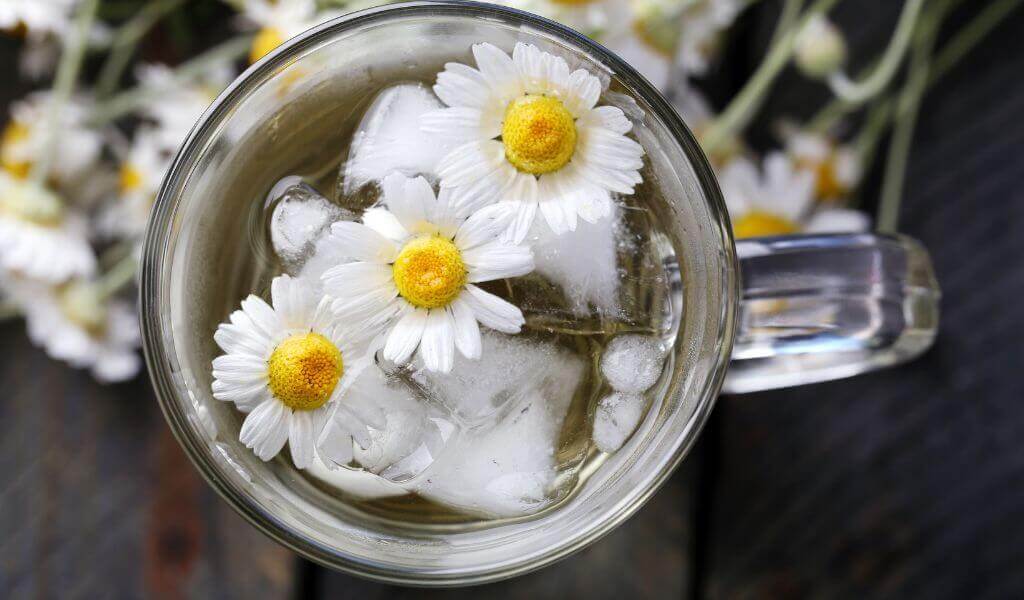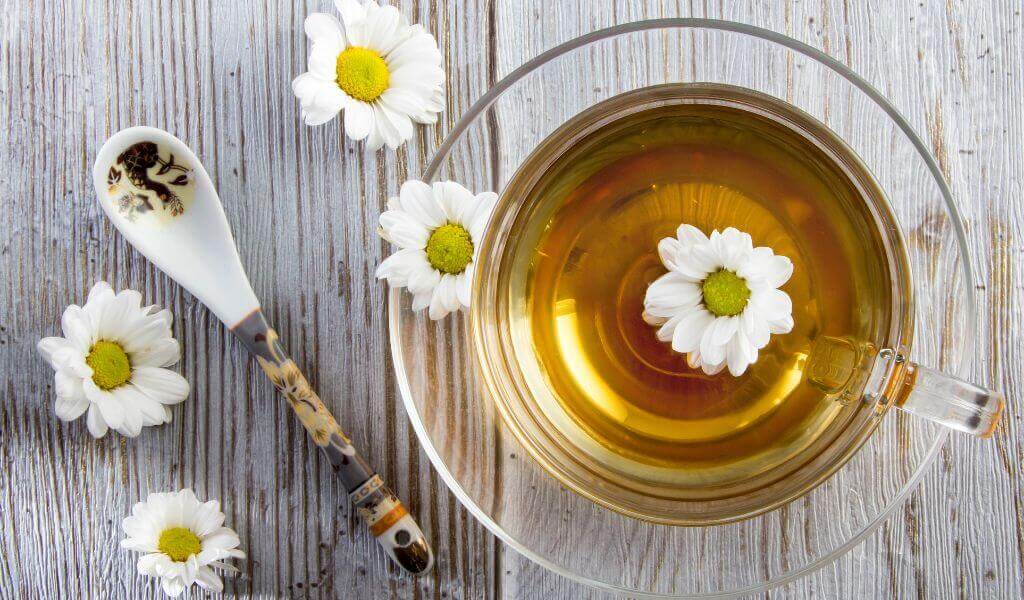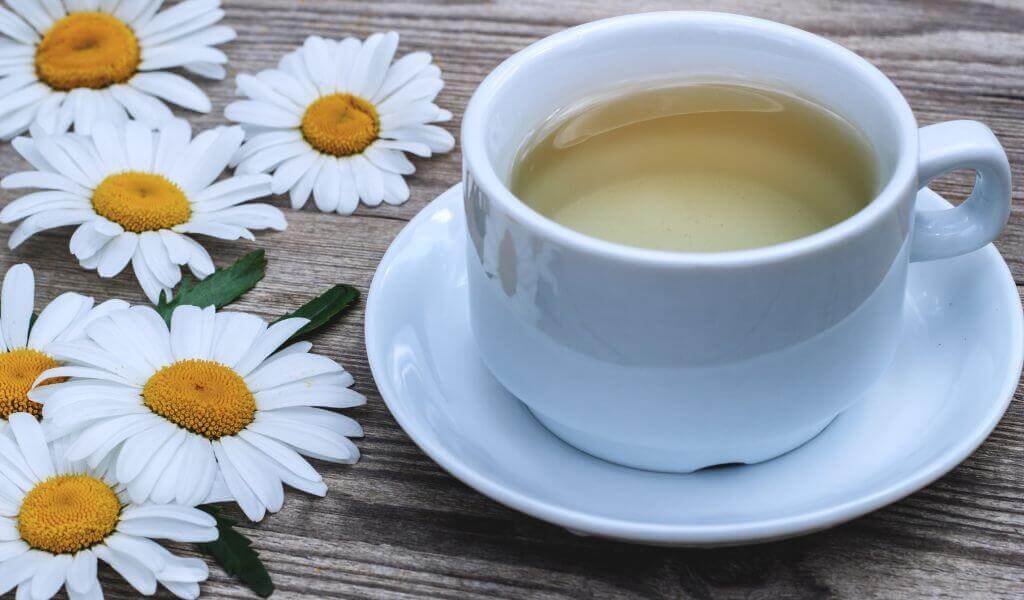How to make Chamomile tea with dried flowers or tea bags is so easy and enjoyable, and I’m excited to share it with you!
This healthy, calming herbal tea comes in a range of flavors to suit your taste, whether you prefer it warm and comforting or iced and refreshing.
You should learn how to prepare chamomile tea if you enjoy herbal drinks like mint and ginger. It has a wonderful soothing effect that is excellent for relaxing after a stressful day.
This simple homemade chamomile tea recipe (manzanilla tea) can be enjoyed as a soothing, warm cuppa or an excellent, refreshing Chamomile iced tea. And the best part? You have several delicious flavor add-ins to choose from!
First, I want you to know…
What part of chamomile is used for tea?
The part of the chamomile plant used for tea is the flower. Specifically, the dried flower heads, which contain the plant’s essential oils, give chamomile tea its distinct flavor and calming properties.
So when you’re making chamomile tea, either with loose dried flowers or tea bags, it’s these lovely little flower heads that you’re steeping to create that delightful, soothing beverage.
For making Chamomile tea, it is essential that you…
Choose Your Chamomile tea
Loose Tea
Loose teas are a fantastic choice for those who drink a lot of tea. Not only can they be used to make large batches, but they can also be purchased in bulk, saving us the trouble of unwrapping and preparing individual tea bags.
Loose teas come in various flavors and blends, often more affordable than tea bags. Plus, with loose tea, i have more control over the flavor; if you prefer a milder taste, simply use less tea.
Tea Sachet
A tea sachet is a little bag of thin silk or paper containing tea leaves. To steep the tea, I just place the sachet in a pot or basin of hot water, similar to a teabag.
The pyramid-shaped design of many sachets allows the tea leaves to expand in the warm water, resulting in a richer-tasting tea. Tea sachets have become quite popular in restaurants, cafes, and hotels. One downside is the extra waste they produce, as sachets typically aren’t reusable. That being said, there are some reusable options available.
Tea Bag
Tea bags are small pouches made of paper or fabric filled with tea and meant for Chamomile tea brewing temperature. I often see them offered at the checkout counter in grocery stores, and they’re promoted as fast, convenient, and easy to use.
However, I think loose-leaf teas are just as easy to brew and offer even more flavor. Similar to tea sachets, tea bags create extra waste, as they are usually thrown away after each use.
The Chamomile Tea Ingredients
- Chamomile: To whip up this delightful loose leaf chamomile, you’ll need food-grade dried flowers or a convenient teabag.
- Water: This will serve as the foundation for your soothing tea.
- Sweetener: (optional) Enhance the natural flavors of your herbal tea with a touch of honey – it’s a match made in heaven! But feel free to choose any sweetener that suits your taste, such as vegan dandelion honey, agave, maple syrup, good ol’ granulated sugar, or even a sugar-free option like erythritol or stevia!
Quotes of tea with You
Teatime is a chance to slow down, pull back, and appreciate our surroundings. – Letitia Baldridge
What To Add To Chamomile Tea?
Here are some you can add to Chamomile tea:
- Citrus: Give your tea a zesty twist with a splash of lemon, lime, or orange juice. You can also infuse it with citrus zest while it steeps.
- Ginger: Add fresh chamomile tea with ginger slices for a refreshing zing.
- Lavender: Toss in edible dried lavender to steep or sweeten the tea with a hint of lavender syrup.
- Vanilla: A dash (about 1/8 teaspoon) of pure vanilla extract creates a scrumptious honey-vanilla chamomile tea.
- Cinnamon: Spice it up by adding cinnamon (stick or powder) while steeping.
- Herbs: Basil or mint (including fun flavors like apple mint) can add a lovely aroma and subtle taste.
Gently heat the water and any chosen ingredients from the list on your stovetop for 10-15 minutes, which will help bring out their flavors more effectively. Afterward, incorporate the chamomile and allow it to infuse for 5 minutes.
- Milk: A splash of dairy or non-dairy milk makes for a soothing, slightly creamy chamomile hot tea.
- Chamomile Tea Latte: Mix water and milk for a delightful latte variation.
- Iced Chamomile Latte: Brew double-strength tea, let it chill, and then top it off with milk and ice. Vanilla is a great addition here too!
- Apple Juice: Swap some water for apple juice to create a naturally sweet, warm, or iced chamomile tea.
- Green Tea: Add a green tea teabag or loose-leaf green tea for an extra layer of flavor.
- Hibiscus: A pinch of hibiscus adds tanginess and potential health Chamomile tea benefits.
- Berries: Boost your iced chamomile tea with muddled or whole berries, like strawberries, raspberries, or blueberries.
How To Make Chamomile Tea (Manzanilla Tea)?
Now, we guide you on how to make chamomile tea. Remember the golden tea-to-water ratio rule: use 1 tablespoon of chamomile (or 1 chamomile tea bag) for every cup of water. That way, you can effortlessly adjust the recipe for Chamomile tea to create the perfect amount for any gathering.
Warm Chamomile Tea
- First, you’ll need to heat some water until it reaches a boil. You can do this on your stovetop or in a kettle, whichever works best for you.
- When boiling water, put the chamomile flowers in a glass or teapot. Pour the hot water over the flowers, and let them soak for about 4-5 minutes. This will let the flavors come out. After that, strain the tea to remove the flowers. I love adding honey to my chamomile tea if you want to add sweetness. Enjoy your comforting cup of tea!
With the benefits of Chamomile tea, you can use an infuser or strainer to keep the flowers contained while they steep. If you’re making tea in a cup, use a small filter that can easily dip into the water. Another option is to create a “tea bag” by wrapping the flowers in a little cheesecloth parcel. This way, you can enjoy a lovely chamomile tea without hassle!
@looseleafteamarket My favorite way to make chamomile tea not boring! Save this for later. . . . . . #remedy #naturalremedy #naturalremedies #naturalmedicine #naturalcure #herbalremedy #holistichealth #homeremedies #homeremedy #naturopathic #healthnut #alkaline #vegan #healthbenefits #healthiswealth #naturalcures #healingwithfood #letfoodbeyourmedicine #healthylifehappylife #health #healingfoods #remedies #plantbasedvegan #letfoodbethymedicine #fyp #foryoupage
Iced Chamomile Tea
So, with iced Chamomile tea, how to make chamomile tea from the plant? I love preparing iced chamomile tea by following the instructions mentioned above, letting it cool down, and then serving it over ice with a few pieces of diced fruit. It’s so refreshing!
Some suggest letting the chamomile (and any other ingredients you might want to add) steep in hot water for an hour or longer. However, I’m hesitant to do that because chamomile can get bitter if it’s overstepped. Don’t let me stop you from experimenting if you want to try that!
If you’re into a longer steeping process, I’d recommend cold brewing the tea in cold water overnight for up to 20 hours. It’s a great alternative that gives the tea a lovely, smooth flavor.
I will share a few tips.
How to make chamomile tea taste better
I adore Camomile tea, and it’s my best way to drink chamomile tea! I love experimenting with various spices to discover new and delightful flavors. Here are some delicious recipes I’ve tried and can’t wait for you to enjoy:
- Use high-quality chamomile: Start with good quality loose-leaf or premium chamomile tea bags to ensure a fresh and flavorful base.
- Adjust steeping time: Experiment with the steeping time to find the right balance of flavor. Steeping too long may produce a bitter taste, while steeping too short may yield a weak flavor. Generally, 5-7 minutes should be enough.
- Sweeteners: Add a touch of natural sweeteners like honey, agave nectar, or maple syrup to bring out the floral notes and complement the taste of chamomile.
- Add citrus: Enhance the flavor with a slice of lemon or orange. The citrus notes can bring a bright and refreshing element to your tea.
- Blend with other herbs: Combine chamomile with lavender, mint, or lemongrass to create a unique and soothing taste profile.
- Add spices: Cinnamon, ginger, or cardamom can be added to the tea to provide warmth and complexity.
- Experiment with fruits: Add a few berries, such as raspberries or blueberries, or a slice of apple to your tea for a fruity twist.
- Use flavored water: Steep your chamomile tea in flavored water (like coconut water or fruit-infused water) to introduce a subtle, new taste.
- Add milk or milk alternatives: Some people enjoy adding a splash of milk or a milk alternative like almond or soy milk to their chamomile tea for a creamier texture and taste.
- Serve it iced: On a warm day, try brewing a strong chamomile tea, then chilling it and serving it over ice with a splash of lemon or a sprig of mint for a refreshing twist.
Remember that personal taste varies, so feel free to experiment and find the best combination.
Chrysanthemum tea steeping time affects many things; read more.
How long does to steep chamomile tea?
Finding the perfect steeping time for the best chamomile tea brand comes down to personal taste, the type of chamomile flowers you’re using, and the water temperature. The ideal steeping time is usually between 5 to 7 minutes, which allows for a balanced and soothing taste profile. But, of course, everyone’s preferences are different.
When making chamomile tea, I consider a few things:
- If I’m in the mood for a milder tea, I’ll steep it for 3 to 4 minutes.
- When using fresh chamomile flowers, I usually steep them for an additional 1 to 2 minutes compared to dried flowers since they have a higher moisture content.
- I make sure the water temperature is between 190°F and 205°F (88°C and 96°C) for optimal steeping. I adjust my steeping time accordingly if it’s lower or higher than this.
If you’re like me and love experimenting, try steeping your chamomile tea at different times to see how the flavors change. You might prefer a lighter taste, which you can achieve by steeping for only a few minutes. On the other hand, if you’re looking for a bolder flavor, try steeping for 7 to 10 minutes.
But be careful not to over-steep your caffeine-free tea! Steeping for more than 10 minutes can result in a bitter or astringent flavor, which might not be what you want. Just keep an eye on the time and adjust according to your preferences, and you’ll soon discover the perfect chamomile tea experience.
After making a good cup of tea, how to enjoy it is also something you need to know; check out some of my ideas.
Read more: What does Chamomile Tea taste like? A Journey for Your Senses
How To Drink Chamomile Tea Perfectly: My Guide To An Enjoyable Experience
Chamomile tea is the most popular way to consume chamomile. Many people drink it regularly, usually one to four cups per day. Briefly, you can use a chamomile tea bag or chamomile flowers to make chamomile tea. Place the tea bag or flowers in a mug, pour hot water over them, and cover it with a saucer. Let it steep for 5 to 10 minutes. You can enjoy the tea once it has cooled down enough to be safe.
When it comes to savoring chamomile tea, here’s my guide to drinking it perfectly:
- Choose a Favorite Cup: Find a cup or mug that brings you joy and comfort. I prefer one with a wide opening to enhance the aroma.
- Brew Your Perfect Cup: Prepare your chamomile tea using your preferred method. Refer to our previous guide for brewing instructions.
- Appreciate the Aroma: Close your eyes and inhale the enticing aroma of chamomile tea. Let it transport you to a state of relaxation.
- Engage Your Senses: Feel the cup’s warmth in your hands and take in the light golden color of the tea. Let the visual appeal set the stage for your tasting experience.
- Taste Mindfully: Let the chamomile tea linger in your mouth for a few seconds. Notice the subtle, floral taste and the soothing qualities it imparts.
- Create a Calm Environment: Find a quiet spot to unwind. Dim the lights, play soft music, or indulge in meditation. The atmosphere can enhance your tea-drinking experience.
- Be Present: Focus on the moment as you sip your chamomile tea. Let go of distractions and worries. Allow the tranquility of the tea to calm your mind and body.
- Customize to Your Liking: Personalize your chamomile tea by adding natural sweeteners like honey or a squeeze of fresh lemon juice. Experiment to find the perfect balance for your taste.
- Take Your Time: Slow down and enjoy each sip. Let the flavors envelop your taste buds. Embrace the calming properties of chamomile as you relax.
Following these steps can create an enjoyable and mindful chamomile tea-drinking experience. So, grab your favorite cup, brew chamomile tea, and take a moment to unwind and indulge in tranquility.
If you mix it up too much, you can’t drink it all, and you can store it for drunken use. Refer to the following content.
Tea storage
If you have any leftover chamomile tea after brewing it and it has cooled down, you may keep it in the fridge for approximately 3–4 days. The remaining tea can also be put into an ice cube tray for longer-term storage. This manner, you can always have chamomile tea cubes on hand for a cool drink.
So, when it comes to storing organic chamomile, German chamomile, and Roman chamomile, proper storage techniques are essential to maintain their freshness and potency. Here are some guidelines for storing these types of tea:
- Container: Use airtight containers made of glass or metal to store chamomile teas. These containers will protect the tea from moisture, light, and air, which can degrade the tea over time.
- Cool and Dark Location: Store the containers in a cool, dark place away from direct sunlight and heat sources. Excessive heat and light can cause the teas to deteriorate and lose their flavor.
- Avoid Moisture: Keep the tea away from moisture, as it can lead to mold or spoilage. Make sure the container is completely dry before storing the tea and avoid storing it near the stove, sink, or any other humid areas.
FAQS
Can I use fresh chamomile flowers?
I haven’t personally tried it, but I’ve heard that it’s possible to make a delicious chamomile tea. My tip would be to use twice as many fresh flowers as you would with dried ones. For the best flavor, use the flowers on the same day they’re harvested. If you have any leftovers, store them in a ziplock bag with a damp paper towel for a couple more days.
Is chamomile tea good for acid reflux?
There are many personal accounts of chamomile tea being helpful for acid reflux and various stomach problems. It is currently impossible to determine if these assertions are accurate or false since additional scientific data is needed to support them. But if people’s experiences are any indication, chamomile tea could be beneficial.
How long to steep chamomile tea?
Steeping chamomile tea for 3 to 5 minutes is recommended. The good news is that, unlike other teas, chamomile won’t turn bitter if steeped for longer than 5 minutes. This is because chamomile comes from a different plant called Camellia Sinensis
How much chamomile tea should you drink per day?
I suggest drinking up to 4 cups of chamomile tea per day. However, avoiding drinking more than 5 cups is best, as excessive consumption can cause vomiting and other unpleasant side effects.
I’m Shanna, creator of Spiritea Drinks. I’m all about teaching people to grow their own food, tea, cook what they harvest, and eat with the seasons.


